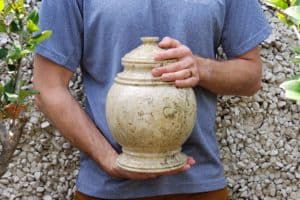As Americans get more comfortable with the idea of cremation, they are considering not headstones and caskets, but what to do with cremated remains, also sometimes called cremains. Although modern day cremation has existed for decades, little is understood about cremated remains.
When we work with a family one of the first things we explain is what cremated remains actually are and how they are created.
Cremated Remains Aren’t Ashes
One of the biggest misconceptions about cremation is that the cremated remains are ashes. Cremains are commonly called ashes because they resemble the wood ashes of a fire. During cremation the retort gets so hot all organic material evaporates so there are no ashes produced at all.
What Cremated Remains Really Are
The only thing that remains after cremation is the bones. All the other organic matter is incinerated. Bone is made up of minerals like calcium phosphates that give it enough durability to withstand the high temperatures. Bones also contain sodium, potassium and a variety of other components.
Here’s an interesting fact: No two people will have the same components in their cremated remains. The exact composition of minerals is different for every person since minerals and metals can absorb into the bone throughout life. The mineral composition is a product of numerous factors like the surrounding environment and diet.
That means cremated remains are like a fingerprint since bone mineral composition is unique to each person.
The mortuary will grind up the remaining bone fragments and that is what the family receives as the cremains. This is why cremains have a rough, coarse texture rather than being powdery like ashes. The cremains are typically off-white to light grey in color, unlike wood ashes that are dark grey.
There Are More Remains With Water Cremation
With traditional flame-based cremation there are about 4-6 pounds of remains, although it varies slightly from person to person based on height and bone density. Roughly 3.5% of the person’s weight is an estimate for the weight of the cremains.
One of the newest options is water cremation, also known as alkaline hydrolysis. There are a number of benefits to the process, which uses a water alkali solution rather than incineration. Water cremation mimics natural decomposition except it’s extremely accelerated. The process is complete in a matter of hours.
The Cremation Association of North America estimates that water cremation results in nearly a third more cremated remains compared to flame cremation. The bone that remains is able to fully dry before being ground and it’s white without hints of grey.
Plants Don’t Grow Well in Untreated Cremated Remains
You can easily bury cremains in a cemetery, and some cemeteries have special areas specifically for this type of burial. When families choose to bury a loved one’s remains they sometimes do so with the intention of growing a tree or plant at the burial site. Few people realize it’s not that simple.
Adding cremated remains to soil doesn’t make the best growing conditions. It can actually make the soil completely unproductive for plant growth because of the high pH level of the cremains. That’s why there are speciality bio urns that help to balance out the pH level so that cremated remains can be used to grow a tree or plant.
If you have questions about the cremation process or cremains, the knowledgeable team at Green Cremation Texas has answers. We can be reached by phone, text or email any time of day.




